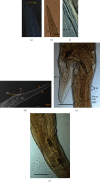Morphometry and Molecular Identification of Haemonchus Cobb, 1898 (Trichostrongylidae: Nematoda) Isolates from Small Ruminants in Tanzania Based on Mitochondrial cox 1 and rRNA-ITS genes
- PMID: 36698385
- PMCID: PMC9870690
- DOI: 10.1155/2023/1923804
Morphometry and Molecular Identification of Haemonchus Cobb, 1898 (Trichostrongylidae: Nematoda) Isolates from Small Ruminants in Tanzania Based on Mitochondrial cox 1 and rRNA-ITS genes
Abstract
The genus Haemonchus is the major abomasal parasite of ruminants responsible for substantial economic losses in tropical and temperate regions. This study was conducted to clarify the morphometry and molecular characterisation of Haemonchus species isolated from sheep in Babati district, Tanzania. A total of 486 trichostrongylid nematodes were recovered from five sheep. Of the total worms, 106 nematodes were distinguished by 37 males and 69 females. The asymmetrical length of dorsal ray and the distance of bulb at the apex of spicules were used for identification of males. In females, the linguiform vulvar flap was the most predominant with 33 out of 69 (48%) compared with knobbed morph type which was 25/69 (36%) and smooth morph type with 11/69 (16%). Partial cox1 sequence fragments of Haemonchus contortus isolates showed 98.8%, 99.3%, 99.7%, 99.5%, 99.3%, and 98.4% in male, smooth, knobbed, linguiform A, linguiform B, and linguiform C, respectively; with the average nucleotide divergence ranged from 1.03 to 2.35%. The amplified fragments of ITS-2 genes in knobbed, linguiform A, and smooth morphotypes revealed 99.4%, 98.5%, and 98.3%, respectively. Phylogenetic analysis was evaluated by employing Bayesian inference and maximum-likelihood, and the tree was distinctly separated into three clusters focusing on H. contortus in cluster I within the family Haemonchidae. Genetic drifting, mutation, and modification of the morphological features of the Haemonchus species described to have an impact on the development of drug resistance. Species identification is necessary to understand which species infect animal host. We recommend more studies on the parasites intensity and the strategies for controlling Haemonchus species in Tanzania.
Copyright © 2023 Barakaeli Abdieli Ndosi et al.
Conflict of interest statement
The author(s) declare(s) that they have no conflicts of interest.
Figures





Similar articles
-
Morphological and molecular characterization of Haemonchus contortus isolated from the small ruminants of south Gujarat, India.Helminthologia. 2023 Sep 22;60(2):175-188. doi: 10.2478/helm-2023-0020. eCollection 2023 Jun. Helminthologia. 2023. PMID: 37745222 Free PMC article.
-
Ecological, morphological and genetic characterization of sympatric Haemonchus spp. parasites of domestic ruminants in Mauritania.Parasitology. 1995 May;110 ( Pt 4):483-92. doi: 10.1017/s0031182000064829. Parasitology. 1995. PMID: 7753587
-
Haemonchus longistipes Railliet & Henry, 1909 (Nematoda, Trichostrongylidae) from the Egyptian dromedary, Camelus dromedarius (Artiodactyla: Camelidae), first identification on the basis of light and ultrastructural data.Parasitol Res. 2014 Dec;113(12):4579-85. doi: 10.1007/s00436-014-4148-6. Epub 2014 Oct 3. Parasitol Res. 2014. PMID: 25273629
-
Systematics of gastrointestinal nematodes of domestic ruminants: advances between 1992 and 1995 and proposals for future research.Vet Parasitol. 1997 Nov;72(3-4):225-38; discussion 238-45. doi: 10.1016/s0304-4017(97)00099-x. Vet Parasitol. 1997. PMID: 9460200 Review.
-
The Identification of Haemonchus Species and Diagnosis of Haemonchosis.Adv Parasitol. 2016;93:145-80. doi: 10.1016/bs.apar.2016.02.023. Epub 2016 Mar 31. Adv Parasitol. 2016. PMID: 27238005 Review.
Cited by
-
Morphological and molecular characterization of Haemonchus contortus isolated from the small ruminants of south Gujarat, India.Helminthologia. 2023 Sep 22;60(2):175-188. doi: 10.2478/helm-2023-0020. eCollection 2023 Jun. Helminthologia. 2023. PMID: 37745222 Free PMC article.
-
Molecular Characterization and Analysis of Human Trichostrongylus Species in an Endemic Region of Iran Based on COX 1 Gene; A Cross-Sectional Study.Health Sci Rep. 2025 Apr 18;8(4):e70612. doi: 10.1002/hsr2.70612. eCollection 2025 Apr. Health Sci Rep. 2025. PMID: 40256140 Free PMC article.
-
Molecular Detection and Characterization of Haemonchus spp. in Cattle in Nigeria.Iran J Parasitol. 2024 Oct-Dec;19(4):448-456. doi: 10.18502/ijpa.v19i4.17165. Iran J Parasitol. 2024. PMID: 39735845 Free PMC article.
References
-
- Sambodo P., Prastowo J. Morphology and morphometry of Haemonchus contortus in goats in Yogyakarta, Indonesia. Jurnal Kedokteran Hewan . 2018;12(3):62–65.
-
- Rege J. E. O., Tembely S., Mukasa-Mugerwa E., et al. Effect of breed and season on production and response to infections with gastro-intestinal nematode parasites in sheep in the highlands of Ethiopia. Livestock Production Science . 2002;78(2):159–174.
-
- Wang F., Xu L., Song X., Li X., Yan R. Identification of differentially expressed proteins between free-living and activated third-stage larvae of Haemonchus contortus. Veterinary Parasitology . 2016;215:72–77. - PubMed
-
- Allonby E. W., Urquhart G. M. The epidemiology and pathogenic significance of haemonchosis in a Merino flock in East Africa. Veterinary Parasitology . 1975;1(2):129–143.
-
- Kuchai J. A., Ahmad F., Chishti M. Z., et al. A study on morphology and morphometry of Haemonchus contortus. Pakistan Journal of Zoology . 2012;44(6):1737–1741.
LinkOut - more resources
Full Text Sources
Miscellaneous

